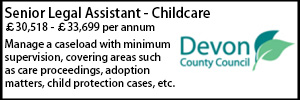‘Suitable’ vs ‘Appropriate’
- Details
Olivia McGonigle looks at the lessons to be learned from a recent Upper Tribunal ruling in relation to naming schools in EHC plans.
The appeal to the Upper Tribunal in LC and RC v Hampshire County Council [2023] UKUT 281 (AAC) concerned, among other things, the test that should be applied when section I of an Education Health and Care Plan (‘EHCP’) is in dispute. A question was raised in the proceedings about the difference between the tests which are present in sections 39 and 40 of the Children and Families Act 2014 - whether a school is “unsuitable for the age, ability, aptitude or special educational needs of the child or young person concerned” and whether a school is “appropriate for the child or young person”.
The appeal concerned a child, “O”, whose parent wanted Section I of the EHCP to be left blank and for education otherwise than in school (‘EOTAS’) to be provided. The local authority’s case was that “C School” should be named in Section I. The parent advanced a case that while ‘suitable’ and ‘appropriate’ in sections 39 and 40 have similar meanings, they are not identical. There was no dispute that the school in question was suitable for the child considering the age, ability, aptitude and special educational needs. However, the parent argued, that did not mean it was appropriate: when looking at the ‘appropriateness’ test, further consideration was needed about the wider circumstances which could include things that would fall outside age, ability, aptitude or special educational needs.
Before the Upper Tribunal it was common ground that the First-tier Tribunal applied the test in section 39(4)(a), namely, whether C School was suitable for O’s age, ability, aptitude, and special educational needs, but that, as a matter of law, it should have applied the test of section 40(2)(a) – was C School appropriate for O? The Upper Tribunal held that the First-tier Tribunal’s error in applying the wrong legal test was not material. The mistake did not cause them to overlook or insufficiently take into account certain welfare/safety risks highlighted in evidence from an occupational therapist (which described O as a “potential target” in a school which catered for pupils with social, emotional and mental health behavioural needs). Consequently, if they had applied the correct test, they would have come to the same conclusions.
The appeal is also notable because the Upper Tribunal gave some consideration to whether a school should be named in a case where provision will be made otherwise than in a school to begin with and it is anticipated that there will be a long transition into school. This point was not pursued in the appeal, but the Upper Tribunal did express some concern about what it means to ‘attend’ a school, emphasising the need to consider NN v Cheshire East Council [2021] UKUT 220 (AAC). While the judgment did not express a view on the position where there is an extended transition plan, some attendance is required at the school within a defined period of time. It is a factor that should be considered when assessing transitions back into school settings.
Olivia McGonigle is a barrister at 3PB.



































